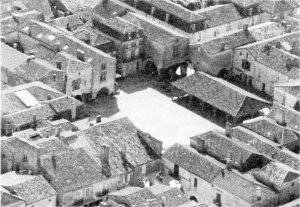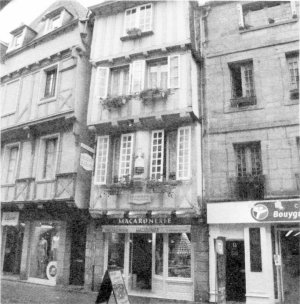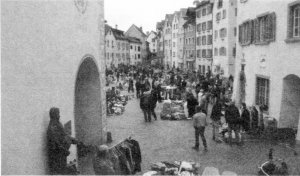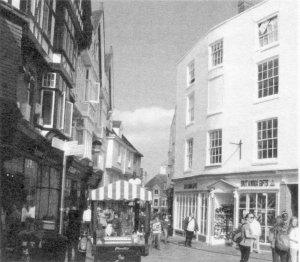Some Thoughts on Housing - TrustNews Sept 15
As no doubt everybody is aware, the Government is attempting to press for a large increase in housing throughout the land. Hampshire and, in turn, Winchester has to take a share. Brown-field land is often mentioned, but of course many historical towns generally have very little, if any such land. No doubt, as in other historical cities and towns, it will be difficult to absorb the numbers allocated without having a dramatic effect on the historical centres. Winchester has to absorb 4,000 houses which will mean a rise in population of over 20%.

Central square of ‘bastide' town in southern France
Winchester’s problems are little different from those being experienced in other historical cities and towns in the south of the country. Apart from the problems of absorbing the growth, there is the impact of car movement to consider. ls it possible to look on the housing demand as an opportunity to think differently and forget we are likely to be lumbered with yet more developer-lead estates, which are car-infested and therefore destructive to the way in which layouts are designed?
Let us consider three key criteria that currently create the estate layout: car provision and vehicle movement, housing density, and building materials and services.
Vehicle movement

4/5 storey buildings in a Brittany town street
There is no doubt that cars are a major problems when mixed with pedestrian and bicycle movement. They take up a huge amount of space with the demand for roads, turning requirements and parking. They pollute with harmful emissions, particularly when moving slowly. And they dictate the aesthetics of a built environment, dictating the use of the space they take up which they also devalue.
At the same time it has to be recognised that a car is considered a useful tool and used correctly is an asset. Most people would consider a car a valued necessity and probably wish to park it as closely as possible to their front door! The potential gains of resolving the problems associated with vehicle movement are obvious: attractive pedestrian routes, peace at night, enhanced community spirit, less pollution, and the possibility of higher density of building. The economic benefits therefore are huge - less infrastructure required, more compact housing, together with shorter routing for all services, resulting in sizeable savings on materials.
If one considers the housing numbers that are involved on many estates, that is, 1000-3000, then some will differ in their layout and circulation requirements. For example, some sites could be sloping and some spread green-field sites etc. However just considering a broad green-field site such as Barton Farm, which is typical of many such sites, then it might be possible to achieve a substantially car-free estate.

Market space in Chur, Switzerlande
Do estates need to be linked to a town or city core or can they be looked at as a village or small town? After all the people numbers generated are much larger than most villages. Linking large estates to historic towns and cities creates and exacerbates congestion and if Winchester is anything to go by the problem is unresolved. If housing estates are de-linked from town centres then car movement would be substantially reduced and could possibly be further reduced by providing local shops, a farmers’ market type facility, offices, surgeries, schools with hall provided for cinema/ theatre/evening use and recreation areas, inevitably questions arise. For example, could car parking be situated around the perimeter of an estate with no more than a 10 minute walk to any house? Would it be possible to provide an electric buggy for each car owner to transfer shopping/children from car to house? This would be a very small extra cost in relation to the price of a house.
Housing Density
Planners and many of us seem very averse to density. Currently most estates today are being constructed at a density of 30-40 to the hectare. This figure includes infrastructure. In Winchester we do have much high densities - the Hyde area, for example, is nearer double. Many Cotswold villages have around 70 dwellings to the hectare. Bath and many historic city centre sites have an even higher density.

Mixed high density development in Canterbury
Assuming 70 houses to the hectare, the land take-up therefore leaves over 50% for other uses, with the possibility of limiting car movement within the built zone and providing car parking at the perimeter of the built area. The result would be much reduced pollution levels, far more pleasant street landscaping, less damage to built fabric, and the release of parking areas and garaging for more useful purposes - in fact a generally more relaxed environment would be created.
Building materials and services
In considering the materials used for buildings as well as those used to construct the infrastructure, there would be a major saving in materials, thereby reducing the selling price. With a higher density there would be a greater potential for a central heating source and it might also be possible to harness the centralisation of waste to improve heating resource. And greater housing density would improve insulation potential, also saving on heating requirements. We should be considering all this for 21st century housing anyway.
I have written this article as a question - should we still be building housing estates that pay little regard to the wellbeing of a community? Go and look at some of the recent building estates around Winchester or Andover for example and I hope you see what I mean. Surely we should be considering a better approach to housing in the 21st Century?
